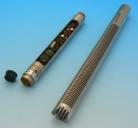
It allows to keep PV going, with more focus towards AI, but keeping be one of the few truly independent places.
-
Don't have enough time to make a thorough post but following is the design I am currently working on to be powered by a 9V battery. In terms of sound the performance is on the level of a sound devices without the metering, limiter, monitoring and various output options. I'll add more info tomorrow.
Included is also a picture of a prototype board I made. I am using an input transformer I pulled from a yamaha console I modified last year but any audio input transformer in the 1:3 to 1:6 region will work fine with slight modifications of the zobel/loading at the input.
For all who are interested I think we can make something really great in the $100 neighborhood if we put our minds together. Some good suggestions made already.
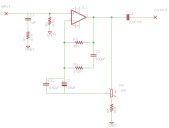
 SpaceAmp Schematic.png698 x 530 - 7K
SpaceAmp Schematic.png698 x 530 - 7K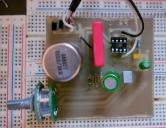
 Ocmponent side.jpg800 x 616 - 428K
Ocmponent side.jpg800 x 616 - 428K -
INA217 opamp? We have a good limiter on the GH2 board, and peakmeters, so this opamp will make sense when it also provides +48V phantom power. Double-mono configuration would not be bad... Great work!! I guess, we could probably start a group-buy when the amp is finished. diyaudio.com would also be a good place to discuss this amp, many experts there
-
Very interested! Only thing that I really need in addition to high quality preamp would be a way to monitor whats coming in. 48V phantom would be nice as well, but i could live with a mignon inside the mic.
Have you thought about powering the circuit from the "mini" phantom power coming out of gh2 mic port?
-
Hello all,
Happy to see some people out there excited about making their own gear.
@simurg I don't know anything about the constitution of a shotgun mic. All I care is that it works and has low self-noise. As for the opamp I am currently trying out different low-noise types. LME49710, OPA627, LME49990, AD797, LT1128, etc. The 741 is old technology with horrible noise figures so not even a consideration.
@frame Once I get this version of the preamp running smoothly I will try one of the the single package instrumentation amplifiers such as the INA103 or THAT1510 which eliminate the need for a transformer and the various components they require. My criteria is that the noise floor remain as low as possible. In my experience so far, however, no single chip mic pre seems to be able to equal or beat the noise performance of a low-noise opamp with a transformer in front of it. I would love for that not to be the case as transformers are one of the biggest expenses in making these pres. Since I have a Sennheiser MKH416T with a seperate unit providing phantom power I have not included phantom power for this particular iteration but I have breadboarded the phantom unit as I plan to make a stereo mic preamp for a Superlux S502 I have recently acquired.
@meierhans To monitor what is coming out would require an addition headphone amp in the circuit. This would be fine if I was going to be recording straight into the GH2 but I have had horrible luck trying to feed a line level signal in the MIC IN port of the GH2. It is next to impossible to get a decent level and metering and I can't eliminate the limiter kicking in even when I have the gain set at the lowest setting on the preamp AND on the GH2. I have tried adjusting the parameters with Ptools as per thepalalias's excellent work on the subject but all to no avail. I would love to be able to record directly into the GH2 but I've resigned myself to the idea of recording sound separately and syncing in post (something for which I've developed interesting techniques). This means I have not looked into powering from GH2's phantom. The good part, however, is that all one requires is a decent portable recorder with 1/8 line in jack with this preamp (which automatically includes the ability to monitor). No need for DR-100 or R26 or other expensive recorders.
In its current form the preamp is being powered by one 9 Volt battery. I just finishing making the power supply board today, basically a very simple dual rail splitter with 3 capacitors to smooth out ripple and provide noise reduction. I'll keep you all posted on the developments. Feel free to ask questions.
-
@spacewig At work I am running ART USB Dual Pre into GH2, converting from Line level to Mic level with a DIY voltage divider just before the signal runs into the cam. While the ART USB Dual Pre sucks in terms of noise level when pulling up the gain high enough to record somebody in normal "movie making" distance from a shotgun mic, the connection between the preamp and GH2 work very good. In other words: If I set it to Level 1 in GH2 (Pasadena Settings) and Gain on Preamp to 3/4 and then speak directly into the mic (10 cm) I get very clean audio out of the GH2. The meters inside the cam also react in a meaningful way (thanks to Pasadena again..).
The USB Dual Pre supports monitoring, but the signal you get out of the headphone jack is pretty low. Too low for using our normal Sennheisers, but enough to drive in-ears.
Did you read the tread about voltage devider? Can´t find it anymore, its so long ago. Thanks to it I was finally able to feed line level into GH2.
-
@meierhans There's a cable made by Sescom that takes line-out to mic level, and also splits the line-out to drive a set of headphones.
-
Thanks for the suggestion! That means we could simply lower the gain ratio by modifying the 30 Ohm resistor (R5 on the schematic above).
What are the values of the resistors of your voltage divider?
-
@brianluce noted
-
A "fitting" preamp to the GH2 should (and other cams with mic inputs) should provide 0dB full scale at 0,035V RMS. This is about -27dBu. Could be done with a switch to a voltage divider. Feature of many pro mixers to switch between line level and mic level at the outputs. I habe a MKH-416 as well, but no phantom powered extender, I am using an SQN like mixer (SIE MP-232) from the early eighties. Weights three times more than the GH2 with 14-140. Still waiting to evaluate an Audiolink III, something like the ART USB Dual pre. But I guess it will also not have transformers...
-
@frame Thanks for the info re" mic input. I just finished trying out a new power supply board as the last one had an issue with arc'ing and had to be scrapped and the layout rerouted. When I get back from work tomorrow I will try recording again with the gain structure modified as per the suggestions made above.
Does anyone know if Sedna AQ1 comes with thepalalias' Pasedna patch as default?
edit: Below is a picture of the pre with power supply plugged into the 3.5mm line in of a tascam dr-2d (an absolute energy hog, NEVER buy this p.o.s.) for testing purposes.
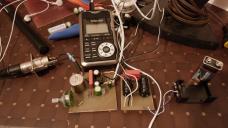
 GH2 Mic Preamp.jpg1493 x 840 - 374K
GH2 Mic Preamp.jpg1493 x 840 - 374K -
I modified the gain values and can report the unit sounds very good (going into the dr-2d line in); It is very low noise indeed. I wanted to test it on the GH2 but the 2.5mm jack I bought was defective so I have to wait until I get another one before I can report further. In the meanwhile, below is the schematic of the power supply.
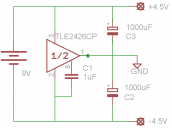
 9V PSU Schematic.png523 x 389 - 5K
9V PSU Schematic.png523 x 389 - 5K -
@Meierhans Happy you're interested. Lets keep the conversation going in this thread.
I will record some demos of the preamp on Friday with a friend so you can hear the difference between it and preamps that come stock with most recorders (in this case a tascam DR-40).
-
Don't know why I haven't seen this thread before.
@spacewig, Nichicon ES bipolars.. Nice. I love those caps. I recapped my recording console with those.
Interesting feedback design. Is there a reason you chose to do multiple feedback loops with varying responses?
Honestly, I think the THAT1570 ICs are extremely good for what they are. Probably plenty low noise for most usage.
Equivalent input noise (Ein) = Sqrt of bandwidth of audio * noise (in volts) and then solve Ein*gain for output noise.
As I mentioned in the hardware hacks thread, most electret and small diaphragm condensers are generally more noisy than the preamps they are plugged into.
-
Also, this is probably the best, cleanest, most neutral sounding and lowest noise preamp but it's also labor intensive DIY:
http://www.studio21.ch/diy/neeno/ssl9k/DIY_9k_Preamp.pdf
This one is a lot easier:
http://www.extremecircuits.net/2010/07/low-noise-microphone-amplifier-op270e.html
-
Great to see things are moving here. I dont remember the exact values of the voltage devider, could anybody link back to the old thread?
A small, high quality mic preamp with low power consumption and switchable line/mic output level... this could be useful in many situations, not just with GH2.
-
http://www.epanorama.net/circuits/line_to_mic.html
Everything you need to know about line-to-mic level pads.
-
The circuit itself is an early Neve IC preamp design I got from the JLM audio website which I modified slightly. The only things that would have to be changed is the zobel and load (R1, R2 and C1) depending on the input tranny used as the values on the schematic above are tweaked for the Tamura GA8027.
The feedback network is a slope from 32Khz - 3 Mhz (originally R3 was 100K or16.7Khz - 3Mhz) and the explanation I was given was that the early transformers had a bump in the high end which was then compensated for with this feedback filter which also eliminated RFI
The SSL 9000 is a fantastic mic pre but way too complicated for simple DIY purposes and would probably consume ~ 8 times the amount of current if not more. I would not want to run it on a 9V battery... This design draws no more than 10mA (without phantom) which means it would run around 50 hours on an alkaline battery.
I'd be interested in trying a pre using a THAT IC but first I want to try a design I know works well, is relatively simple to build, and has a transformer at the front end (I have quite a few kicking around).
BTW, thanks for the links. I think another option might be to have a switch allowing us to change the bottom leg (R5) of the gain network so that we can control the amount of gain the pot will give us (i.e. 20ohm/2K would allow to us to chose between 60db or 20db)
Howdy, Stranger!
It looks like you're new here. If you want to get involved, click one of these buttons!
Categories
- Topics List23,992
- Blog5,725
- General and News1,354
- Hacks and Patches1,153
- ↳ Top Settings33
- ↳ Beginners256
- ↳ Archives402
- ↳ Hacks News and Development56
- Cameras2,367
- ↳ Panasonic995
- ↳ Canon118
- ↳ Sony156
- ↳ Nikon96
- ↳ Pentax and Samsung70
- ↳ Olympus and Fujifilm101
- ↳ Compacts and Camcorders300
- ↳ Smartphones for video97
- ↳ Pro Video Cameras191
- ↳ BlackMagic and other raw cameras116
- Skill1,960
- ↳ Business and distribution66
- ↳ Preparation, scripts and legal38
- ↳ Art149
- ↳ Import, Convert, Exporting291
- ↳ Editors191
- ↳ Effects and stunts115
- ↳ Color grading197
- ↳ Sound and Music280
- ↳ Lighting96
- ↳ Software and storage tips266
- Gear5,420
- ↳ Filters, Adapters, Matte boxes344
- ↳ Lenses1,582
- ↳ Follow focus and gears93
- ↳ Sound499
- ↳ Lighting gear314
- ↳ Camera movement230
- ↳ Gimbals and copters302
- ↳ Rigs and related stuff273
- ↳ Power solutions83
- ↳ Monitors and viewfinders340
- ↳ Tripods and fluid heads139
- ↳ Storage286
- ↳ Computers and studio gear560
- ↳ VR and 3D248
- Showcase1,859
- Marketplace2,834
- Offtopic1,320

